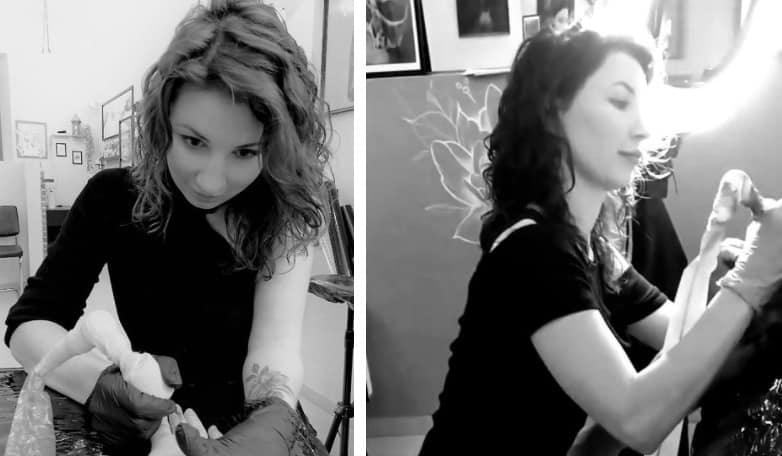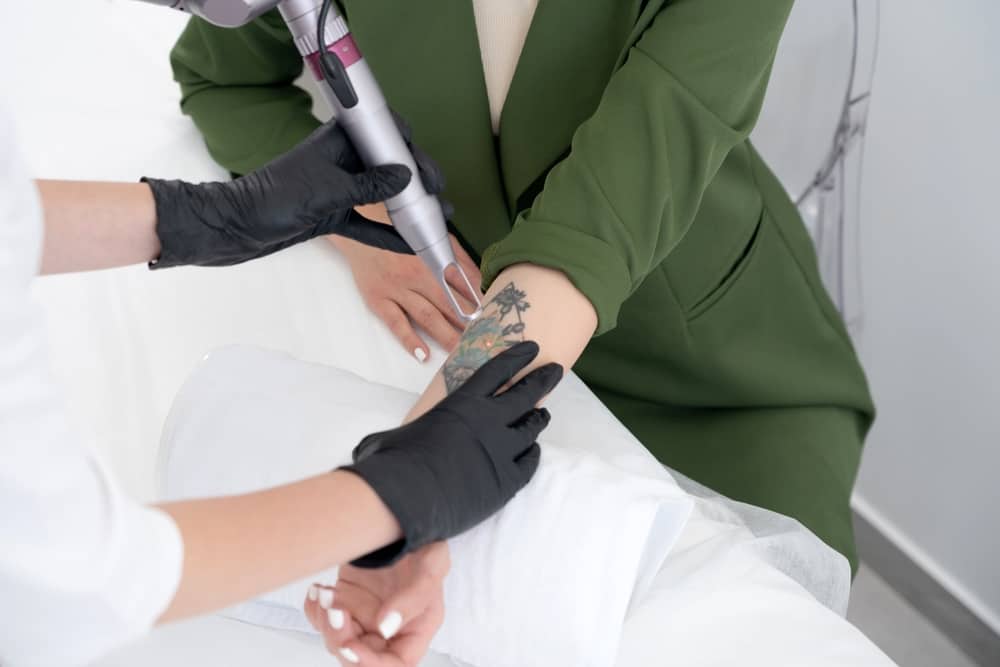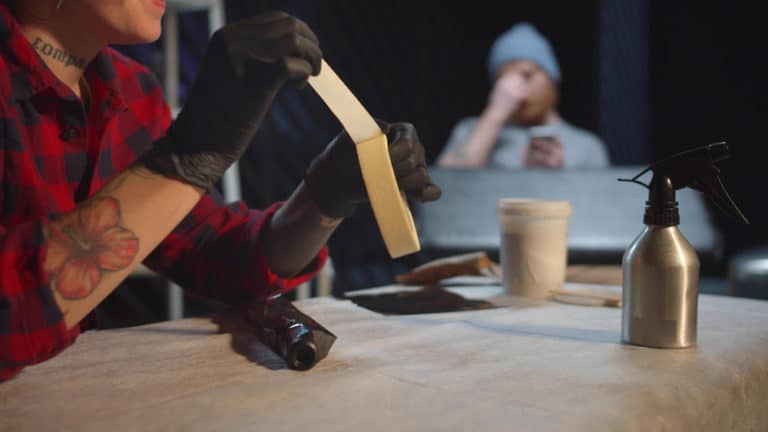What Is A Medical Grade Tattoo?
Tattoos are not merely for show and are not a recent development. In the present era, people acquire tattoos for a variety of reasons. But may someone opt to have permanent tattoos for any other reasons? Yes, and there is a medical cause. In light of this, you might want to understand just what a medical-grade tattoo is.
Medical grade tattoos are used to treat medical conditions, provide medical information, or designate a bodily spot for medical operations or future examination. In addition, many people with critical medical issues utilize medical tattoos instead of medical bracelets.
Medical grade tattoos are permanent skin markings that serve a range of medicinal reasons. Furthermore, several different contexts are associated with the term “Medical” when it refers to tattoos. With that in mind, let’s take a deeper look at what a medical-grade tattoo may mean.
Medical Grade Tattoos: What Are They?
Applying tattoos for medical reasons is common and dates back to 3300 BC. Medical tattoos are merely tattoos with two functions—one for cosmetic and one for medicinal purposes.
These include positional tattoos used as landmarks during radiation therapy, reconstruction of the nipple-areola complex following breast cancer surgery or reduction, endoscopic tattooing for surveillance, camouflage for burns, corneal injury, and surgical or traumatic hypochromic scars. In addition, it is also used for vitiligo, scarring, or persistent alopecia, lip contouring, and color alteration.
Although this is not recommended for youngsters and is frequently mistrusted by doctors, tattoos have also been used as medical alert identification in emergencies. In addition, tattoos are increasingly being utilized in forensic pathology to identify and compile a personal history of the deceased.
As you can see, tattooing has been included in various medical applications and will continue to evolve for its many uses. That said, the following are some of the most common uses.
Medical Grade Tattoos Can Replace Medical ID Bracelets
Typically, a person with a medical problem could wear a medical identification bracelet to communicate their health status to emergency personnel quickly. Because they include crucial information like severe allergies, prescriptions, if a patient has diabetes, Alzheimer’s disease, etc., first responders are trained to search for them on a patient’s wrists and neck.
But if you want something more permanent, you can consider getting a medical tattoo, considered the most common impression of a medical-grade tattoo.
For instance, rather than spending money on medical wristbands, a person with Type 1 diabetes can get the words “Diabetic, Type 1” tattooed on their arm or wrist. Others could have gotten “No CPR” tattooed on their chests to express their desire not to accept life-saving procedures if their hearts cease beating.
Paramedics and several medical experts advise care before making the transition, though. Paramedics and hospitals aren’t required by law to abide by the American Medical Association’s recommendations since there aren’t any yet addressing medical tattoos.
That said, medical personnel might be unable to find the tattoos if they aren’t on the wrist or are augmented with a design, potentially defeating the purpose. Additionally, tattoo permanence becomes a concern as medical illness evolves. However, in an emergency, paramedics search for information that will help them treat a patient, and a tattoo can undoubtedly be used.
Medical Grade Tattoos Can Be Used For Radiation Marks
Not all medical tattoos are applied to replace medical bracelets. For example, the radiologist may have to tattoo numerous cancer patients with small tattoos roughly the size of freckles during radiation therapy. As a result, to identify the specific treatment region, these tattoos are employed.
Patients usually receive one to four radiation tattoos, while individual cases may need more. These tattoos are created with ink and a needle and are permanent, just like any other tattoo. But frequently, they leave behind a painful reminder of cancer that the radiation therapy cured. As a result, many individuals decide to get them taken out.
Medical Grade Tattoos Are Used For Reconstructive Procedures
A growing area for medical tattoos is cosmetic, including plastic and reconstructive surgeries to conceal scars, severe lacerations, burns, or to treat skin conditions like vitiligo or even baldness.
For instance, the breasts’ nipples are frequently removed during a mastectomy. Patients frequently elect to undergo surgery to reconstruct their nipples and then have the areolas tattooed so that they appear black surrounding the new nipples.
According to Breastcancer.org, skilled nipple tattoo artists can now produce incredibly lifelike 3D nipples. Although they look three-dimensional, these tattoos are flat on the breast. Because it heals more quickly and leaves fewer scars than nipple reconstruction surgery, more women are selecting this option.
Other patients elect to have substantial chest tattoos without undergoing reconstructive surgery. The tattoos provide a whole new body image and can aid in erasing the psychological and physical scars that the disease and surgery left behind.
Medical tattooing under these circumstances — for cosmetic and reconstructive surgery — had excellent patient results, according to a 2021 research issued in the journal Plastic and Reconstructive Surgery.
However, the authors argued that to “protect the public and assure the greatest quality service,” there should be a set method for training and a defined curriculum for the medical tattoo industry.
How To Get A Medical Grade Tattoo?
You may be questioning how to obtain a medical-grade tattoo now that you know what they are and the medicinal benefits it may provide. To get a medical tattoo, you must decide what kind of tattoo you require, make a strategy or design for your tattoo, and then actually receive the tattoo. With that in mind, the following example is some of the essential steps to getting a medical-grade tattoo.
Planning Your Tattoo
You must choose or brainstorm a tattoo design, except for radiation tattoos (which will be tiny dots). You will still need to make confident choices even if you want something straightforward like plain text for a medical alert tattoo or meat tag tattoo (similar to “dog tags” for US military personnel).
This journey is a personal choice, but remember that you would need something paramedics, and doctors would be able to recognize.
Start searching online for ideas if you want your tattoo to be more intricate. After that, see a tattoo artist to go through the specifics. Most artists will create a bespoke design for you, while some could demand a fee.
You Would Need To Choose A Location On The Body
Depending on the sort of tattoo you require, and the size you choose, your tattoo’s placement will change. You can get assistance from a tattoo artist with this choice. Be mindful that some body parts need more pain tattooing than others (such as the rib cage). Some examples of locations include:
- The post-mastectomy tattoo will appear on the chest.
- The upper rib cage is the usual location for meat tag tattoos (military dog tags); however, they can also be seen on the chest.
- To decide where tattoos for radiation should be placed, see your doctor.
- Tattoos with medical alert symbols may be seen all over the body. Consider having your tattoo placed on your wrist or forearm, where you would typically wear a medical alert bracelet, to maximize the possibility that a medical expert would notice and identify it.
Consult With Your Doctor
Any medical tattoo requires careful consideration. As a result, talking to your doctor about it is a bright idea. In addition, your doctor can assess whether or not you are healthy enough to have a tattoo if you have a condition or have just undergone a medical operation (such as a mastectomy). Therefore, it is also essential to talk about your medical status.
In the same breath, as medical conditions change, several aspects and treatments are managed differently. For instance, if you are in a car accident and the doctors treat you according to the specifications in your tattoo, but your medical condition is no longer at that stage, you might endanger your life.
With that in mind, if you are uncertain of your condition and potential development, you would need to consult with your doctor.
Get Your Medical Grade Tattoo Done By A Tattoo Artist
Locate a trustworthy tattoo parlor. Start by searching online for tattoo shops in your region or asking friends for suggestions. Then, make plans to visit a few stores. It would help if you combed for the following in a reliable store:
- An uncluttered setting is an indication of a clean environment
- Tattooists that use gloves when applying the tattoo are a must
- Look for certificates that are hung on the wall, including a CPR certification and one for a “bloodborne pathogens” training course.
- Do some research on the artwork done by the artist. You can always inquire about their portfolio.
Having selected an artist, a design, and a spot on your body, all you need to do now is turn up for your appointment. Your tattoo artist should be able to provide you with a ballpark time estimate for the tattoo. Be advised that having a tattoo may be uncomfortable depending on the tattoo’s placement and your pain threshold.
Always Follow The After-Care Instructions
After getting a tattoo, it’s crucial to take proper care of it. In essence, a tattoo is an open wound. Infection and slow healing brought on by improper maintenance might harm the tattoo. As a result, the following are general ideas of what you can expect.
- Leave the bandage on for at least an hour after the tattoo is finished
- Remove the bandage after an hour and wash your tattoo with fragrance-free antibacterial soap
- Apply a little layer of unscented body lotion after washing
- You would need to repeat this program more than once or twice daily
- For 3–4 weeks, until your tattoo has healed, avoid scratching, bright sunlight, and swimming
What Ink Is Used For Medical Tattoos?
When medical markers are tattooed during radiation using medical grade tattoo ink, mostly, this is only to make sure they will be unharmed throughout radiation treatment. Additionally, the package will include several colors to denote various treatment locations and intensities.
Depending on the application, various inks can be used for medical tattooing. However, most individuals merely go with their own choice of colors and traditional or organic inks for medicinal bracelets alternatives and numerous repair projects. The colors of traditional inks are created using the following:
- Black ink would be made of nickel.
- Red for Mercury.
- Red, orange, and yellow can also be achieved using cadmium.
- White or yellow require zinc.
- Lead for white, green, or yellow.
- Blue from cobalt.
- Aluminum for violet or green.
- For white, titanium or barium can be used.
- For brown, crimson, or black, use iron.
What Is The Approach To Becoming A Medical Tattooist?
There is a long and diverse history to the practice of permanently marking skin by injecting ink or color into the dermis. This form of employment, better known as tattooing, calls for creative aptitude, notably the capacity to sketch.
The correct layer of skin must be penetrated to make a tattoo and successfully prevent needless discomfort. Working as a tattoo artist, medical artist or permanent makeup technician are career options.
The University of California – Los Angeles (UCLA) health system states that medical tattoo artists may employ their abilities to hide surgical scars or to add color to skin after breast cancer reconstructive surgery.
Rendering to the New York Langone Medical Center, permanent cosmetic treatments can also include permanent lip color, eyebrows, and eyeliner for patients who have trouble applying makeup due to arthritis, stroke, or makeup allergies.
Additionally, piercings serve as permanent cosmetics and forms of body art. You may ensure you’re fulfilling the criteria for tattooing and cosmetic experts in your state by completing a training program and gaining certification or license in the area. In light of that, the following is what you would need to know.
Training Would Be Required Followed By Certification
If you aspire to become a tattoo artist, you need to be naturally talented in the arts, which you may develop via art lessons. You may also consider studying cosmetology, which can teach you how to care for your skin.
However, most tattoo artists don’t undergo professional training from a college or university, according to the Alliance of Professional Tattooists (APT). You’ll instead complete an apprenticeship, which typically lasts three years. To learn the craft, you’ll toil under the guidance of an experienced tattoo artist.
Additionally, you can join the APT or the Society of Permanent Cosmetic Professionals (SPCP), which can assist you in adhering to state rules when they are created. You can get certification as a professional tattooist, an associate tattooist, an associate non-artist, or a cosmetic tattooist through the APT.
You must complete studies in permanent cosmetics, nursing, ethics, and bloodborne pathogens to get certified by the SPCP. After that, you must pass a test in anatomy, physiology, infection control, and pigmentology. Although they differ from state to state, some states have the training, certification, or licensure requirements.
Conclusion
Tattoos have traditionally been seen as fashion statements. Still, a smaller percentage of Americans now use them to alert emergency personnel of severe medical issues, conceal a surgical procedure, or convey a medical journey, among other things.
As a result, medical-grade tattoos have changed (and even saved) the lives of countless people. As more creative tattoo artists lend their talents to the cause, tattoos will continue to advance and become more prevalent in the medical field.
Some of my favorite designs, tattoo books, and aftercare products, selected for you

Thank you for reading my article, I hope that you have found it helpful. If you would have trouble finding ideas for your tattoo, wonder what is meaning of design that you have found or what to buy for aftercare, to make sure that your tattoo will be healing quickly and easily, here are some of my favorite products in one place, hope that this will also help.
Design and tattoo ideas
For some ideas you can have a look at those 3 books with hundreds of designs that I use with my clients, they are available on Amazon for Kindle or in classic, paper version (links below):
- Great Book of Tattoo Designs, Revised Edition: More than 500 Body Art Designs (Fox Chapel Publishing) Fantasy, Celtic, Floral, Wildlife, and Symbol Designs for the Skin by Lora Irish
- The Big Book of Small Tattoos – Vol.1: 400 small original tattoos for women and men by Roberto Gemori
- Tiny Tattoos: Over 1,000 Small Inspirational Artworks by Rebecca Vincent.
Tattoo meaning
If you would like to read more about the meaning of different tattoo styles and designs before you will decide what you would like to have, I can recommend a book that was really useful for me when I was starting my tattoo adventure – it’s “Conscious Ink: The Hidden Meaning of Tattoos” by Lisa Barretta (through the link you can find it on Amazon for around $10).
Tattoo aftercare
The skin at the tattoo site often dries out. To prevent it and speed up healing for my clients, I usually recommend one of those tattoo aftercare balms (you can find them on Amazon):
References
- https://en.wikipedia.org/wiki/Medical_tattoo
- https://journals.lww.com/plasreconsurg/Fulltext/2021/11000/The_Medical_Tattoo_Assistant__Guidelines_for_an.80.aspx
- https://www.oncolink.org/cancer-treatment/radiation/support/radiation-therapy-tattoos
- https://pubmed.ncbi.nlm.nih.gov/7870787/
- ncbi.nlm.nih.gov/pmc/articles/PMC8214112/
- wikihow.com/Get-a-Medical-Tattoo







